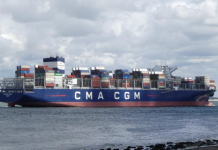
Kalmar has introduced a new range of G-Generation top loaders with improved hydraulics, fuel consumption and operator ergonomics.
Top loaders are typically used in container terminals for moving loaded containers from trailers to a stack or vice versa and are the preferred choice where selectivity is a higher priority than high container density.
The G-Generation top loaders, which replace the previous F-Generation range, feature a variable hydraulic lifting system, which, according to Kalmar, provides exactly the right amount of lifting power based on the weight of the load, meaning the driver does not have to rev the engine while lifting.
“The variable hydraulic system reduces fuel consumption and emissions by up to 10%; further savings are enabled by a more efficient driveline and a lock-up gearbox that uses the engine’s power more efficiently,” commented David Malmström, business development manager, Kalmar forklift trucks.

“The ergonomically designed cabin with improved visibility and fully adjustable steering wheel, seat and control panels makes the driving experience safer and less stressful,” added Andreas Cortelius, product manager, Kalmar forklift trucks.
The unveiling of the new Kalmar’s equipment comes almost a week after the announcement of the merger between Kalmar’s mother company, Cargotec and maritime equipment manufacturer, Konecranes.
Furthermore, the new G-Generation top loader can be delivered with Kalmar’s Eco-Drive feature, which can cut fuel consumption and emissions by a further 15%.
To minimise downtime, the new-generation machines have improved diagnostics, an optimised chassis and fewer moving parts and components. Kalmar highlighted that easily accessible service points and extended service intervals make their maintenance quicker, easier and more cost-effective.
“The G-Generation top loader represents a significant advance in terms of driver ergonomics and productivity,” pointed out Malmström, who went on to say, “Customers can also benefit from increased safety through upgrade options such as a reverse warning system, tyre pressure monitoring and additional lighting.”
“The new electrical system continuously controls and checks the condition of connected subsystems such as the engine and gearbox,” noted Cortelius.





